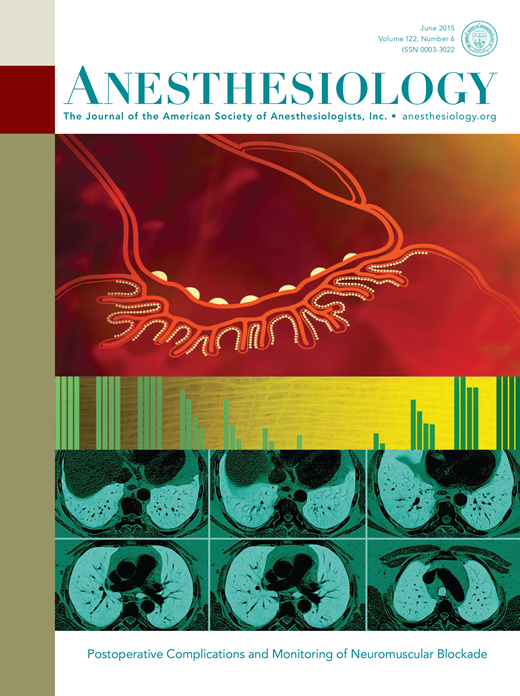Associations between SNAP-25 gene polymorphism, autonomic nervous system activity and recovery of consciousness from propofol anesthesia.
IF 9.1
1区 医学
Q1 ANESTHESIOLOGY
引用次数: 0
Abstract
BACKGROUND The release of synaptic neurotransmitters and function of pre-synaptic proteins are essential for maintaining nervous system excitation. General anesthesia is a reversible state characterized by the loss of consciousness and reduced responsiveness. This study hypothesized that polymorphisms in one or more genes encoding the three pre-synaptic proteins comprising the SNARE complex affect consciousness and autonomic nerve function during propofol anesthesia. METHOD One hundred thirty preoperative patients volunteered to undergo a simulated anesthesia procedure. The participants were genotyped for candidate single-nucleotide polymorphisms using the Sanger method. Changes in verbal commands, eyelash reflexes, and the ability to hold a weighted object during anesthesia induction and recovery were recorded. Further, other anesthesia endpoints such as effector compartment concentrations (Ce), bispectral index BIS, heart rate variability (HRV), and peripheral perfusion index (PPI) were explored, based on the polymorphic site of significant differences in consciousness. RESULTS The results show that the recovery time of verbal commands of the synaptosome-associated protein 25 (SNAP-25) rs6039822 G/G genotype (G/G vs. A/A, 319 (259-378) vs. 379 (318-466) s, P=0.048) were shorter. Logistic regression analysis showed that SNAP-25 rs6039822 and sex were independent factors influencing the recovery of verbal commands (χ2 = 11.916, P=0.008). Other consciousness indices, Ce, HRV and PPI, support the resistance of the SNAP-25 rs6039822 variant to anesthetic during recovery. CONCLUSIONS Genetic variation in SNAP-25 gene is associated with the recovery of consciousness and autonomic nervous system activity during propofol anesthesia. This finding supports that the pre-synaptic proteins may be related to the mechanism of action of propofol.SNAP-25基因多态性、自主神经系统活性与异丙酚麻醉后意识恢复的关系
突触神经递质的释放和突触前蛋白的功能对维持神经系统兴奋至关重要。全身麻醉是一种可逆状态,其特征是意识丧失和反应性降低。本研究假设,在异丙酚麻醉过程中,一个或多个编码SNARE复合体的三种突触前蛋白的基因多态性会影响意识和自主神经功能。方法130例术前患者自愿接受模拟麻醉。使用Sanger方法对参与者进行候选单核苷酸多态性基因分型。记录麻醉诱导和恢复过程中口头命令、睫毛反射和握住重物的能力的变化。此外,其他麻醉终点,如效应室浓度(Ce)、双谱指数BIS、心率变异性(HRV)和外周灌注指数(PPI),基于意识显著差异的多态位点进行了探索。结果突触体相关蛋白25 (SNAP-25) rs6039822 G/G基因型(G/G vs. A/A, 319 (259-378) vs. 379 (318-466) s, P=0.048)言语指令恢复时间较短。Logistic回归分析显示,SNAP-25 rs6039822和性别是影响口头命令恢复的独立因素(χ2 = 11.916, P=0.008)。其他意识指标Ce、HRV和PPI支持SNAP-25 rs6039822变体在恢复过程中对麻醉的抵抗。结论异丙酚麻醉时SNAP-25基因的遗传变异与意识恢复和自主神经系统活动有关。这一发现支持突触前蛋白可能与异丙酚的作用机制有关。
本文章由计算机程序翻译,如有差异,请以英文原文为准。
求助全文
约1分钟内获得全文
求助全文
来源期刊

Anesthesiology
医学-麻醉学
CiteScore
10.40
自引率
5.70%
发文量
542
审稿时长
3-6 weeks
期刊介绍:
With its establishment in 1940, Anesthesiology has emerged as a prominent leader in the field of anesthesiology, encompassing perioperative, critical care, and pain medicine. As the esteemed journal of the American Society of Anesthesiologists, Anesthesiology operates independently with full editorial freedom. Its distinguished Editorial Board, comprising renowned professionals from across the globe, drives the advancement of the specialty by presenting innovative research through immediate open access to select articles and granting free access to all published articles after a six-month period. Furthermore, Anesthesiology actively promotes groundbreaking studies through an influential press release program. The journal's unwavering commitment lies in the dissemination of exemplary work that enhances clinical practice and revolutionizes the practice of medicine within our discipline.
 求助内容:
求助内容: 应助结果提醒方式:
应助结果提醒方式:


